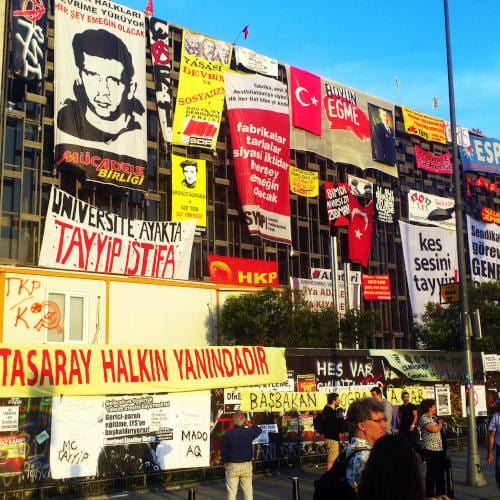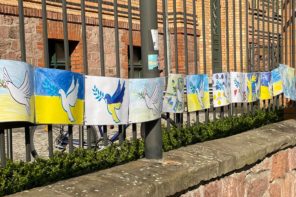“Police, Provocation, Politics” by Deniz Yonucu is an ambitious text that documents the long and complicated history of dissident populations and spaces in urban Turkey in the context of diverse policing and counterinsurgency techniques used by the Turkish state forces. Based on ethnographic fieldwork in Devrimova, an Alevi working-class neighbourhood, where dissident leftist/socialist groups have been active, Yonucu traces the changing strategies of state interventions designed to manage political dissidents and isolate the neighbourhood from the rest of the city. Yonucu delves into state archives and analyses security reports, documents and training manuals on counterinsurgency, and demonstrates how global counterinsurgencies inform Turkish policing and counterinsurgency tactics first in Northern Kurdistan and later on in the dissident neighbourhoods of Istanbul.
Yonucu claims that counterinsurgency techniques are not about ending disorder, but rather about managing and bringing it to controllable levels, thereby transforming certain spaces into low-intensity conflict zones. The aim of generating disorder is first and foremost to reduce political struggles to “security” and “terror” issues, and to mark those places as no-go areas in the public psyche. Drawing upon different examples of counterinsurgencies around the world and comparing them with Turkish policing, Yonucu points out that the effectiveness of counterinsurgency informed by the legacy of the Cold War and (de)colonial eras relies on depoliticizing and decontextualizing political struggle of dissident groups and depicting them as mere actors of “irrational” violence. In Devrimova, residents and revolutionary groups have attempted to engage with practices of local governance and vigilantism for addressing local problems and taking immediate actions against injustice and exploitation long inflicted upon working-class Alevis and Kurds. Yet, to quell the left-wing mobilization in such neighbourhoods, starting from the 1990s, state security forces have employed a new counterinsurgency strategy that consisted in triggering ethnosecterian tensions, violent provocations, introducing new anti-terror laws, while overlooking drug dealers and gangs. Therefore, Yonucu argues that counterinsurgency does not solely imply police violence. All other instruments of counterinsurgency have been applied primarily to divide potentially dissident groups and generate disorder among them through what she calls “provocative counter-organization”. These techniques are therefore adapted by the Turkish state into the logic of its security practices to divorce dynamics and practices of “subaltern counter-publics”(Fraser 1990) of the urban dissidents from its socio-political and historical causes. In other words, policing functions as anti-politics.
The aim of generating disorder is first and foremost to reduce political struggles to “security” and “terror” issues, and to mark those places as no-go areas in the public psyche.
Chapter 1 examines how the neighbourhood became a sanctuary space for working-class Alevi communities in which the long historical resentment against them has met the predicaments of working-class people and the mobilization of socialist groups since its establishment in the 1970s. This chapter chronicles the history of how residents as political actors became involved in local self-government and socialist experiences. While the leftist/socialist struggles of the 1970s were deeply interrupted by the 1980 military coup, Chapter 2 examines how the leftist revival re-emerged in Devrimova, in parallel to the Kurdish movement and revolutionary groups. Meanwhile the re-emergence of leftist mobilization was thwarted and transformed by different policing strategies of counterinsurgency by the Turkish state forces.
To understand these strategies, Chapter 3 focuses on what Yonucu calls “affect-and-emotion generating provocative counterorganization techniques”. By that she means how the ruling elites in Turkey have intervened in the management of the dissident groups with various affective, and divisive, security strategies to disrupt and partition political assemblages, frame their political struggle within the boundaries of ethnosecterian cleavages and confine violence into certain spaces. In turning those spaces into low-intensity conflict zones, Yonucu argues that the state calls for, and provokes counterviolence among socialist groups in a vicious cycle of revenge and retaliation, further racializing and marginalizing them in the eyes of both the public psyche and their constituency. Specifically based on the events that took place in the 1990s, the chapter investigates state attempts, backed by the media discourses, which aim to make the causes of political unrest pointless and relocate the revolutionary violence on the street to the (ir)responsibility of racially framed “deviant” and “impenitent” groups. Chapter 4 documents the vigilante practices of revolutionary groups which, starting in the early 2000s, have been dealing with the absence of the police for preventing criminal activities and drug gangs in the neighbourhood. Yonucu sheds light on how certain forms of vigilantism enable security forces to reproduce low-intensity conflict. She points out that while certain groups and associations address the socio-political roots of crimes and drug dealing, some other masked and armed vigilante groups which define themselves as revolutionary reproduce certain methods of punishment employed by the state. She further adds that the selective targeting of revolutionaries by the police has worsened the situation. Turkish policing techniques and the circulation of images of armed and masked revolutionaries in the media have legitimized the containment and continuation of (counter)violence in certain spaces.
In Chapter 5, Yonucu charts how collective memory of past resistances and political martyrs affectively inform the present of revolutionary people. Against the fear propagated by counterinsurgency tactics, many residents manage to create webs of solidarity and resistance through what Yonucu calls “inspirational hauntings”. The affective formation of the selves, therefore, prevents some dissidents from acting in line with the immediacy of rage and fear, and makes them engage with the space in a more community-minded way. By affective formation, Yonucu means that the memories of past resistance and solidarity in the neighbourhood seep into the present of revolutionaries, affecting their self-ethical formation. While those affective formations might lead to being trapped in the cycle of counterinsurgency, they also pave the way for aspirations of resistance against the state forces and function as a barrier to the provocative counterorganization techniques of the Turkish state. The last chapter, in a sense, summarizes the whole discussion around a case study: the Gezi Uprising. Yonucu first summarizes how different class and ethnosecterian segments of society, including residents of Devrimova, forged alliances, and mobilized against the authoritarian turn of the AKP government in 2013. Then, Yonucu draws attention to how the Turkish government and the security forces revisited ethnosecterian tensions and confined police violence to Alevi neighbourhoods, using tactics learnt throughout the 1990s. The book concludes that the Gezi uprising epitomizes the long-term experiences of counterinsurgency techniques used to divide, marginalize and racialize political dissidents, propagate terror among the wider public, trigger ethnosecterian cleavages and confine state violence into “violence-prone” areas.
Yonucu’s book is a very timely and ethnographically grounded piece of work that helps understand policing techniques in urban Turkey while situating it within a broader historical, political and global context. Moreover, throughout the book, Yonucu compares her context with other counterinsurgencies around the world, hence making a meaningful contribution to the anthropology of policing, counterinsurgency, vigilantism and violence/counter-violence. As the last chapter on the Gezi uprising shows, the book provides useful explanations as to why long-term political alliances are difficult to establish in Turkey. In a context of urban segregation, state violence and policing, terror inflicted upon a part of society is usually accompanied by fear experienced by relatively privileged groups. In this context, the book explains why generating disorder in certain spaces is required for the reproduction of fear and terror by which to quell public opposition. In short, policing and counterinsurgency in contemporary urban Turkey have become a powerful mode of restoring the order of the state and the ruling elites. Indeed, through these techniques, the state succeeded to crush alternative ways of world-making and transformed political spaces into certain low-intensity conflict zones, while marginalizing/racializing them.
The book concludes that the Gezi uprising epitomizes the long-term experiences of counterinsurgency techniques used to divide, marginalize and racialize political dissidents, propagate terror among the wider public, trigger ethnosecterian cleavages and confine state violence into “violence-prone” areas.
However, the book seems to suggest that political agency shaped around counterviolence is an effect of power, rather than a situation which developed as a result of political ideologies. That is, certain practices of political groups, such as, clashes with the police and violent struggles on the streets against drug gangs, are considered as having served the ends of the Turkish state forces. While it might be the case, and actually, the book provides theoretically sound arguments to believe so, given that revolutionary violence is a significant point in political ideologies of some socialist groups in Turkey, these counter-practices need to be further examined ethnographically. The perspectives of the revolutionaries and radical groups engaging with radical violent practices would have required further examination so as to further strengthen the author’s arguments regarding the mimetic relation with the state security forces. This is not a substantial criticism, though. Rather it might be related to some limitations of the ethnographic work and Yonucu herself acknowledges in the very beginning that she did not include outlawed revolutionary groups in her work, i.e the groups which are claimed to be the main actors of revolutionary counter violence on the street, and mimetic stately practices.
“Police, Provocation, Politics” is an important and timely book which helps understand the complicated processes of policing and counterinsurgency techniques against political dissidents in Turkey. Its theoretically broad framework and ethnographically grounded analysis provide important insights on contemporary urban policing in Istanbul and its broader societal effects.
References
Fraser, Nancy. 1990. “Rethinking the Public Sphere: A Contribution to the Critique of Actually Existing Democracy.” Social Text, no. 25/26: 56–80.
Featured image by Ekim Caglar (Flickr, CC BY-NC 2.0)








